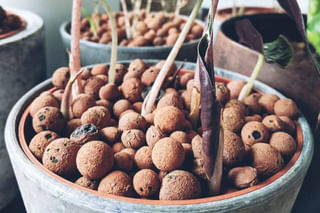How to prepare Leca for first use
Cleaning Leca before you're using it for the first time is very important to keep your plants healthy. In this short guide, we're going over how you can do this and make your Leca ready to be used with your plants
If you're new to using Leca, there are a few things you should know about preparing it for first use. This guide will walk you through the process step-by-step, from selecting the right amount of Leca to washing the clay balls in water.
When you're using Leca for the first time, it's covered in dust. This is not something we want to expose our plants to, so we should wash this off. If you're using Leca that's already been washed, you can skip this process altogether and start planting your plant in the Leca, but if you just bought a bag of Leca (or clay balls) at a store, this guide is very important. When you buy a new bag of Leca at the store, there will be a lot of dust in the bag from the clay balls making contact with each other.
Choosing the right amount of Leca
Before you start cleaning your Leca, it's important to determine the right amount of clay balls you'll need for your plant. Generally, you want to fill your pot up to about an inch under the top with Leca. This will provide your plant with enough space to grow and allow you to water it properly without the Leca spilling over the edges of the pot.
If you're not sure how much Leca to use, you can use the image above as a guide. The image shows a Calathea plant planted in Leca with about an inch of space left at the top of the pot. Once you've determined the right amount of Leca for your plant, you can move on to the next step.
Washing the Leca in water
The first step in preparing your Leca for first use is to wash it thoroughly in water. This is because there will be a lot of dust in the bag from the clay balls making contact with each other during transport. To wash your Leca, fill a bucket with the amount of Leca you'll need for your plant and add water until the Leca is covered.
It's recommended to use a second bucket to make the cleaning process easier. By having two buckets, you can move the washed clay balls from one bucket to another. First, fill the bucket with the Leca with water and wash the clay balls thoroughly. When they're clean, move them into the second bucket, leaving the dirty water in the bucket you used to clean the clay balls. Throw the dirty water away and repeat the process until the leftover water is (almost) clean.
It's important to note that this process may take several cycles to get your Leca fully clean. As you wash the Leca, you'll notice the water becoming less cloudy with each cycle. This means that the Leca is becoming cleaner and you're removing more of the dust and debris. Once the leftover water is (almost) clean, you can move on to the next step.
Drying the Leca
After washing your Leca, you have 2 choices: Use the leca for your plants right away or store it for later. If you're using it right away, you can skip drying the Leca. However, if you're storing the cleaned Leca for later, it's important to let it dry before you store it. You can do this by spreading the Leca out on a clean surface, such as a towel or a tray, and letting it air dry for a few hours.
It's important to make sure that your Leca is completely dry before you store it in a (closed) container. If you store wet or most Leca in a bright spot, it could start to grow algae or attract other unwanted visitors. By making sure the Leca is completely dry, you prevent this from happening.
Conclusion
Preparing Leca for first use can seem like a daunting task, but it's actually a simple process that can help your plants thrive. By selecting the right amount of Leca, washing it thoroughly in water, and letting it dry, you can provide your plants with a clean and healthy growing medium. With these tips, you'll be well on your way to successfully using Leca for your plants.
Thank you for reading this post! I hope it helps you to keep your plants healthy and beautiful! If you're looking for more guides on specific plants, you can always request a plant guide to get a guide for the plant you have trouble with.
Test your plant care knowledge
Quiz completed!
Want to learn more? Sign up for my newsletter to receive free tips in your inbox!
Sign up now!





